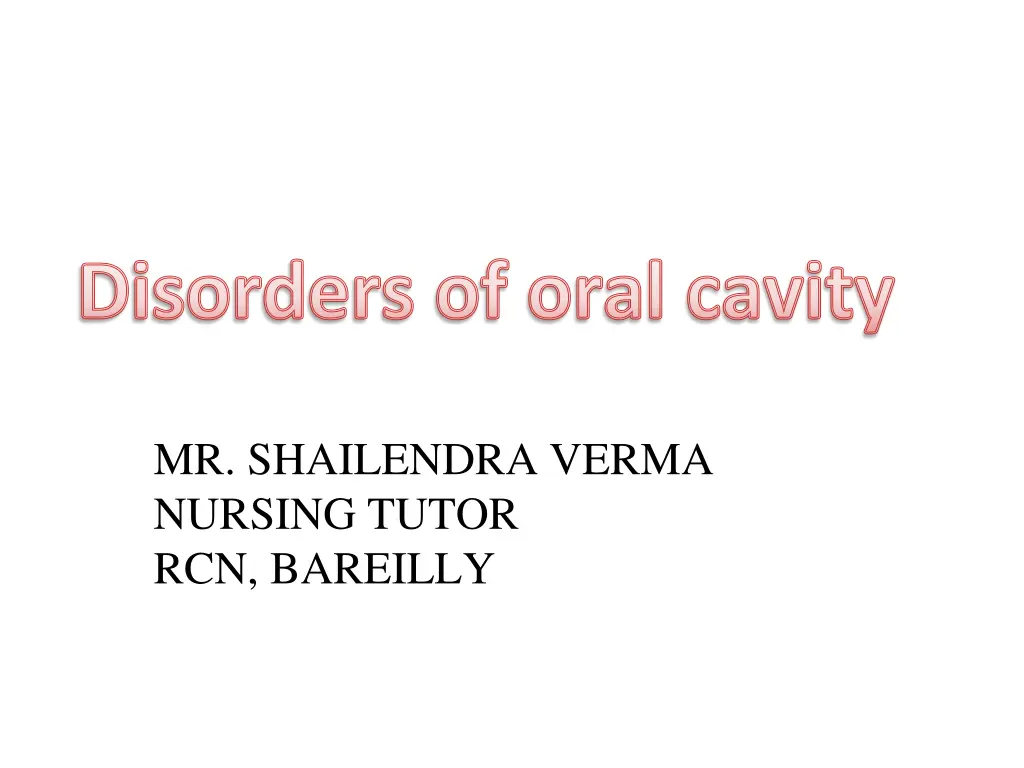
Oral Cavity Disorders: Stomatitis and Gingivitis Explained
Explore the causes, symptoms, and management of stomatitis and gingivitis, common disorders affecting the oral cavity. Understand the importance of early detection and proper care to maintain oral health.
Download Presentation

Please find below an Image/Link to download the presentation.
The content on the website is provided AS IS for your information and personal use only. It may not be sold, licensed, or shared on other websites without obtaining consent from the author. If you encounter any issues during the download, it is possible that the publisher has removed the file from their server.
You are allowed to download the files provided on this website for personal or commercial use, subject to the condition that they are used lawfully. All files are the property of their respective owners.
The content on the website is provided AS IS for your information and personal use only. It may not be sold, licensed, or shared on other websites without obtaining consent from the author.
E N D
Presentation Transcript
Disorders of oral cavity MR. SHAILENDRA VERMA NURSING TUTOR RCN, BAREILLY
SPECIFIC OBJECTIVES At the end of the class teaching the group will be able to:- Introduce the topic Definition Explain the anatomy and physiology Enlist the Etiology List down the types Explain the Sign and Symptoms Explain the diagnostic evaluatio Describe the Management Enlist Complications
ORAL CAVITY Oral cavity consist of 1. Lips 2. Gums 3. Tongue 4. Salivary glands 5. teeth
Stomatitis DEFINITION: Stomatitis is an inflammation of the mucous lining of the mouth , which may involve the cheeks, gums ,tongue ,lips , and roof or floor of the mouth. The word stomatitis literally means inflammation of the mouth
CAUSES 1. Chemotherapy 2. Radiotherapy 3. Loose-fitting dental prosthetics 4. Trauma 5. Poor dental hygiene 6. Smoking 7. Dehydration 8. Medication 9. Burns
Sign & symptoms 1. 2. 3. 4. 5. 6. 7. 8. Pain or discomfort in the mouth. The presence of open sores or ulcers in themouth. Fever ,sometimes as high as 101 104 F . Irritability and restlessness Blisters in the mouth Swollen gums , which may be irritated and bleed. Drooling. Dysphagia. Foul-smelling breath. 9.
Management of Stomatitis 1. Medical management :- bismuth salicylate , sucralfate, antacids Topical analgesics, such as benzamine hydrochloride Topical anesthetics, such as lidocaine viscous Oral or parenteral analgesics, including opioids if needed, for pain not controlled with above Bitadine gargle 2% 2. Other management :- Antiseptic mouth wash Avoid excessive brushing Denture hygiene measures
DEFINITION Gingivitis is a non-destructive type of periodontal disease, but untreated gingivitis can progress to periodontitis.
TYPES OF GINGIVITIS 1. Dental plaque-induced gingival disease :- This can be caused by plaque, systemic factors, medications, or malnutrition. 2. Non-plaque induced gingival lesions:- This can be caused by a specific bacterium, virus, or fungus. It might also be caused by genetic factors, systemic conditions.
Causes 1. Accumulation of bacterialplaque 2. Some diseases like diabetes , HIV 3. Drugs 4. Smoking 5. Ages 6. Poor diet 7. Family history
Symptoms 1. Swollen or puffy gums 2. Dusky red or dark red gums 3. Gums that bleed easily when you brush or floss 4. Halitosis 5. Receding gums 6. Tender gums
Prevention /Management 1. Good oral hygiene 2. Regular dental visit 3. Good health practices 4. Brush twice a day after meal and snack 5. Use soft brush or electric toothbrush 6. Use electric brush and floss daily 7. Stop smoking
1. Abscess 2. Peri-odontitis can lead to loss of teeth 3. Recurrent gingivitis 4. Ulceration of gums
Introduction Glossitis is a condition in which the tongue is swollen and changes color. Finger-like projections on the surface of the tongue (called papillae) are lost, causing the tongue to appear smooth.
DEFINITION Glossitis refers to inflammation of the tongue. Cause change in Size, shape, color, taste, movement
Types According to their severity its divided into 2 types 1. ACUTE:- Acute glossitis is characterized by swollen papillae occurs 1. CHRONIC :- Chronic inflammation not of the substance of the tongue, but of the mucous covering of that organ
Causes 1. Primary causes Bacterial /viralinfection Mechanical irritation fromdentures Tobacco, hot food, alcohol,burns Allergy to toothpaste, mouthwash
2. Secondary causes Iron deficiency anemia Pernicious anemia Vitamin B deficiency Syphilis Ulcer HIV /TB
Symptoms 1. Tongue swelling 2. Difficulty in talking ,swallowing, taste, chewing 3. Pain 4. Fatigue 5. Weight loss 6. Sore throat
Diagnosis 1. History 2. Examination 3. Blood test 4. Oral swab
Complication 1. Discomfort 2. Airway obstruction 3. Dysphagia 4. Dysphonia 5. Recurrent oral infection 6. Abscess 7. Oral cancer
Treatment 1. Good oral hygiene is essential 2. Steroids may be used to reduce the inflammation. 3. An oral suspension of Prednisolone may be used in mild cases 4. Antibiotics, antifungal 5. Proper nutrition 6. Avoid irritant like tobacco, hot, spicy food, alcohol
SUMMERY After completion of my teaching the group will be able to:- Introduce the topic Definition Explain the anatomy and physiology Enlist the Etiology List down the types Explain the Sign and Symptoms Explain the diagnostic evaluatio Describe the Management Enlist Complications






















